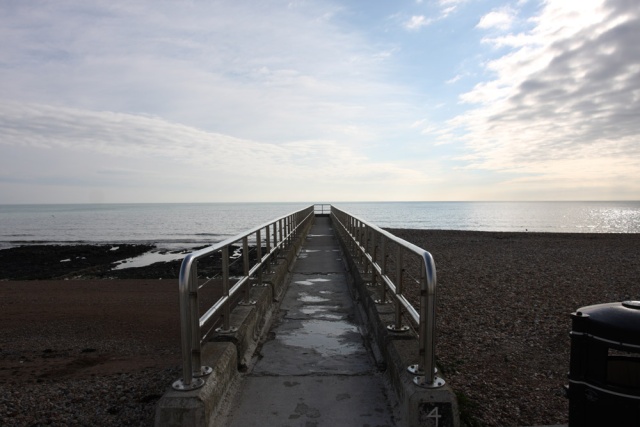As a slight change of pace I'm going back to yesterday for today's post. While I was walking the undercliff at Rottingdean I took a number of shots with a short lens, ideal for landscapes and views. One example was included in yesterday's post. In a couple of places I deliberately took several frames at different exposures. The purpose was to combine the shots to deal with the constant problem of dark and light. With a bright sky and dark foregrounds getting an appropriate exposure is not only tricky, it's probably not technically possible. Camera technology simply cannot record the full range that we can deal with in the flesh. But software can combine shots, and do a number of other clever tricks. And HDR? It stands for high dynamic range.
These are the basic images used. They've had only the most basic processing done, but as is immediately clear, one has been exposed for the sky, and the other for the foreground. Foreground exposure
Foreground exposure
 Sky exposure
Sky exposure
The challenge then arose of how to combine them. I thought about using layers in Photoshop Elements, but to be brutally honest I'm lazy and doubt I could get decent results that way. So I opted for a trial version of something called Dynamic Photo HDR. This does a number of things, but the main functions are aligning the two shots and then mapping the light and dark areas and combining and adjusting the levels. It also allows the addition of colour toning. It adds a logo along the base of the photo, but that's easy to crop (as easy as using the software, which was wonderfully simple). I simply loaded the two images and pressed a few buttons. I overdid the colour toning, but overall the effect is impressive.  hdr version (click for large size)
hdr version (click for large size)
Camera note: image taken with the Canon 40D and EF17-40mm f/4L USM lens.
SittingFox
6 Oct 2010That's an interesting experiment, and a different solution to a filter I guess! The skies over here are very bright and as I've mentioned before, it's very hard not to overexpose them.
Nice result! 🙂
gdare
6 Oct 2010That result look like something I would put on my desktop background. It is amazing what some software can do when, technically, lens can`t. And, of course, what human eye is capable for, when looking at different lights perspective..
:up:
RobinL
6 Oct 2010Words, interesting effects. Funny I have been playing with the exact same thing this last week or so!
I don't know what version of Photoshop you have. I'm using PS3. In PS3 you can merge to HDR. If you haven't seen it, here's how:
Open Photoshop. In the menu, go to File, then click on Automate. Down at the bottom of that menu click on Merge to HDR. It will then give you a page where you can list the files you want to merge, bring them in and then let the program do the rest.
I'm still playing with it, but it seems to work pretty well.
gdare
6 Oct 2010@Robin
Thanks for a tip, I tried it and it works fine :up: As you`ve said it need some adjusting but the result is excellent even with photos I made with my cheap camera :happy:
Ukwildlife
6 Oct 2010Nice one – HDR is something Ive been meaning to play with for a while and this image may just be the inspiration I need!
Words
6 Oct 2010Adele, I'd been meaning to try this for a while. Used carefully it could be quite useful, though really a landscape tool.
Words
6 Oct 2010Darko, the images it produces have a surreal quality. It's not always what I want but I think I might play with it a bit more.
Words
6 Oct 2010Robin, I've been reading about hdr for a long while but never tried it. My version of Photoshop doesn't have the hdr merge facility (I'm using Elements 6), so the stand-alone software was the easiest route. I ought to think about updating to the full PS, but the price is truly horrendous!
Words
6 Oct 2010Neil, it's another learning curve I guess, but the software I used was a breeze.
Words
6 Oct 2010Erwin, yes the images do have a strange look about them. It's easy to overdo the effect and lose any sense of realism.
RobinL
7 Oct 2010Words, Definitely know what you mean about cost!
serola
11 Oct 2010Excellent HDR :up:
A few words copied here in case you decide to remove the HDR image at 365 😀
Folks, I recommend you also got familiar with alternative methods. What HDR really means is High Dynamic Range. Modern cameras already have quite high dynamic range and there are also methods to make HDR images based on one single RAW image. Even JPEG images can have quite good dynamic range, so you may get nice pictures with rich dynamic range just by adjusting the curves or using B/W inverted transparent layer to bring more tones into shadows.
Words
11 Oct 2010Sami, thanks for that. I've been checking your blog for more editing hints :up:
Wulpen
19 Oct 2012Interesting the results looks a bit funny